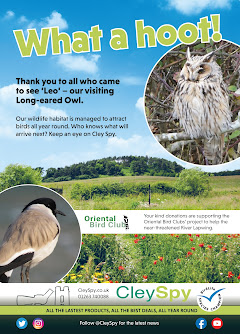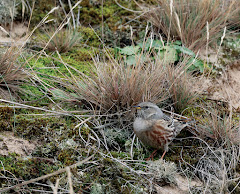Jamie Dunning contacted me recently to ask for my help with the following:
"We study Twite on their breeding territory in the north west of England, and this summer we have colour ringed a good number of birds in order to track where they move to in winter. Previous studies have found most move to the east coast although the evidence is minimal.
We see that there have been some large flocks on the North Norfolk coast and we wondered wether you would help us out in the way of a kind of press release?
We are worried that the flocks on twite on the North Norfolk coast are not being checked for rings and we get how difficult it can be.
We would really appreciate the help from the south east to conserve the iconic bird life of the north west!"
Jamie also highlights in a second email:
"It may interest you to know that one of the Colour ringed birds that has been reported 6 times independently from Thornham harbour has apparently became known to locals as Yorkie. He is a juvenile hatched this year on the Pennines around Rishworth and is fitted with a Yellow ring over the metal and then a Yellow and a White ring on the other leg. seems to be a good model for anyone wishing to photograph Twite if the photo’s I’m being sent are anything to go by."
Colour-ringed Twite in the Pennines!
In conjunction with the RSPB, from Autumn 2014, we have been colour-ringing Twite Linaria flavirostris in the Pennine region of West Yorks. This study has several aims: first, to investigate the changing wintering areas of birds which gather in the area in autumn; secondly to determine whether they remain to breed in the area in summer and thirdly as a means of studying feeding behaviour and range of nesting birds. We will also be assisting with productivity surveys of Twite breeding in the Pennines during the spring and summer to assess population trends over time.
All birds have been ringed with a metal BTO ring on the left leg with a single colour-ring above the metal ring and two colour rings on the right leg. The colours used have been: black (N), white (W), yellow (Y), orange (O), red (R), dark green (G), blue (B) and pale/pastel blue (P).
So far in 2014, c.150 birds have been individually colour-ringed of which 67% were juveniles (Nov, 2014), indicative of a successful breeding season. This included a bird ringed as a nestling in 2009 as part of a previous study, at 5 years 3 months it wasn’t far from beating the longevity record at that time although, it has since pushed to over 6 years! (T Mainwood). While some birds have been re-sighted at locations up to 15km away, one has already been reported from the Lincolnshire another in Flintshire, two in Norfolk and two more in Suffolk (the latter just a week after ringing). We have also noted, as those before us had also found that this population will rove widely for food, 2 birds caught early one morning were re-sighted near Huddersfield that afternoon.
We would be grateful to receive any sightings of these birds, either in the area of ringing or elsewhere. Sightings, including location, date, full colour-ring combinations, and numbers of birds in the flock, should be sent to Jamie Dunning at: jamiedunning8@gmail.com. All sightings will be acknowledged and the finder provided with the original ringing details.
Acknowledgements
Special thanks to those who have run similar projects before us, including David Sowter and Sean Gray and Linda Williams who were kind enough to offer information on previous Pennine Twite work; the Grampian RG for kindly lending us one of their whoosh nets; the people who have tirelessly baited feeding stations, especially Tim Walker and David Sill. Also to the ringers who have offered their time to lend a hand where was needed, Mick Pearson and Gillian Dinsmore; The RSPB Twite Recovery Project, Nick Wilkinson, who co-prepared the CR application, provided our first batch of rings and advised throughout, Tim Melling, Roy Taylor, Jenny Oldroyde, Dave O’Hara, Mike Denton, Kelvin Jones, Alan Draper and Henry McGhie for their useful comments. Then C Atkin, S Whayman, N Lound, A Brown, B Perkins, P Drewy, D Horsey, R S J Smith, S Blain and K Jones for reporting CR birds. Additionally to the above, thanks to the Cley bird club, Lincs bird club, East lancs ornithological society, Calderdale bird club, Bird guides and The BTO for their help in promoting the project.
Jamie Dunning & Steve Christmas
Subscribe to:
Post Comments (Atom)








































No comments:
Post a Comment